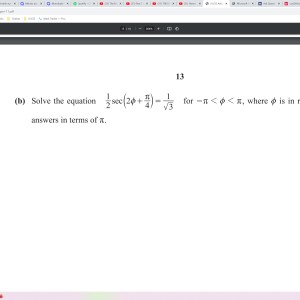How do you go about solving this question?
I've uploaded an image which contains the question.
The answers are $-\frac{5\pi }{24} ,-\frac{\pi }{24},\frac{19\pi }{24},\frac{23\pi }{24} $ But I don't know how you get $\frac{19\pi }{24},\frac{23\pi }{24} $ whenever I try and solve it I only get $-\frac{5\pi }{24} ,-\frac{\pi }{24}$.
 Math Gnome
Math Gnome
87
Answer
Answers can only be viewed under the following conditions:
- The questioner was satisfied with and accepted the answer, or
- The answer was evaluated as being 100% correct by the judge.
 Mathe
Mathe
3.7K
-
Where do we get the 2kπ from?
-
Cosine is periodic with period 2π. This means that cos(x) = cos( x + 2π ) = cos(x - 2π) = cos(x+4π) = cos(x-4π). So if x is a solution to cos(x) = sqrt(3)/2, x+2kπ will also be a solution,
-
The answer is accepted.
Join Matchmaticians Affiliate Marketing
Program to earn up to a 50% commission on every question that your affiliated users ask or answer.
- answered
- 1441 views
- $5.00
Related Questions
- Algebra 1 (6 questions)
- Help deriving an equation from geometry and vectors
- Free Body Diagram: determine the vertical reaction at the left hand beam support.
- Sherical Trig - Distance betwen two points on earth.
- Vector field
- Find the null space of the matrix $\begin{pmatrix} 1 & 2 & -1 \\ 3 & -3 & 1 \end{pmatrix}$
- Given that $-6x \equiv -8 \pmod{7}$, show that $x \equiv 6 \pmod{7}$
- Solving for two unknown angles, from two equations.

